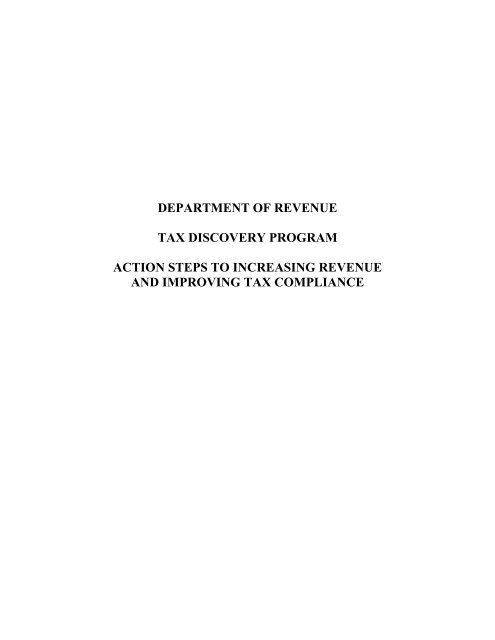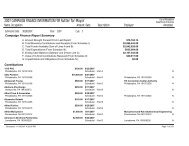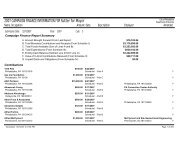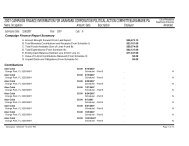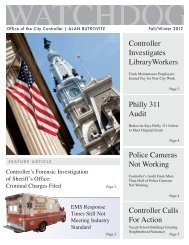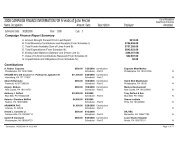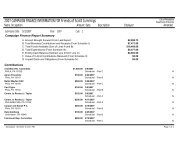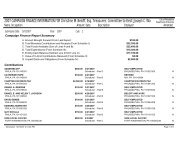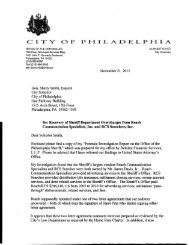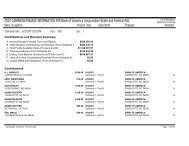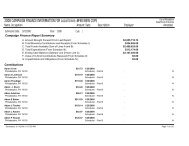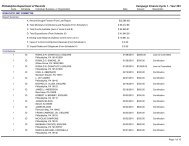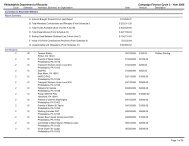department of revenue tax discovery program action steps to
department of revenue tax discovery program action steps to
department of revenue tax discovery program action steps to
You also want an ePaper? Increase the reach of your titles
YUMPU automatically turns print PDFs into web optimized ePapers that Google loves.
DEPARTMENT OF REVENUE<br />
TAX DISCOVERY PROGRAM<br />
ACTION STEPS TO INCREASING REVENUE<br />
AND IMPROVING TAX COMPLIANCE
May 20, 2009<br />
Mr. Keith Richardson, Commissioner<br />
Department <strong>of</strong> Revenue<br />
Municipal Services Building, 6 th Floor<br />
1401 John F. Kennedy Boulevard<br />
Philadelphia, PA 19102-1679<br />
Dear Commissioner Richardson:<br />
Pursuant <strong>to</strong> Section 6-400 (d) <strong>of</strong> the Home Rule Charter, the City Controller’s Office has<br />
performed an assessment <strong>of</strong> the Department <strong>of</strong> Revenue’s <strong>tax</strong> <strong>discovery</strong> efforts. We performed<br />
this assessment <strong>to</strong> compare policies and procedures employed by the <strong>department</strong>’s Tax<br />
Discovery Unit <strong>to</strong> industry “best practices.” A synopsis <strong>of</strong> the results <strong>of</strong> our work is provided in<br />
the executive summary <strong>to</strong> the report.<br />
We discussed our findings and recommendations with you and your staff at an exit<br />
conference and included your written response <strong>to</strong> our comments as part <strong>of</strong> the report. We did not<br />
audit the written response and, accordingly, we express no opinion on it. We believe that our<br />
recommendations, if implemented by management, will improve the effectiveness <strong>of</strong> the<br />
Department <strong>of</strong> Revenue’s <strong>tax</strong> <strong>discovery</strong> efforts. Our recommendations have been numbered <strong>to</strong><br />
facilitate tracking and follow-up in subsequent years.<br />
We would like <strong>to</strong> express our thanks <strong>to</strong> you and your staff for the courtesy and cooperation<br />
displayed during the conduct <strong>of</strong> our work.<br />
Very truly yours,<br />
cc:<br />
ALAN BUTKOVITZ<br />
City Controller<br />
Honorable Michael A. Nutter, Mayor<br />
Honorable Anna C. Verna, President<br />
and Honorable Members <strong>of</strong> City Council<br />
Members <strong>of</strong> the Mayor’s Cabinet
Tax Discovery<br />
Executive Summary<br />
Why the Controller’s Office Conducted the Examination<br />
Concerned about the City <strong>of</strong> Philadelphia’s (City) growing budget deficit, the Office <strong>of</strong> the Controller initiated<br />
this review <strong>to</strong> identify opportunities for generating “new” <strong>revenue</strong>s through <strong>tax</strong> <strong>discovery</strong>. Simply stated, <strong>tax</strong><br />
<strong>discovery</strong> is the collection <strong>of</strong> methods used <strong>to</strong> identify <strong>tax</strong>payers not filing <strong>tax</strong> returns or paying their fair and<br />
appropriate share <strong>of</strong> <strong>tax</strong>es. In a broader context, <strong>tax</strong> <strong>discovery</strong> is a <strong>revenue</strong> enhancement technique with two<br />
underlying objectives: (1) <strong>to</strong> generate “new” sources <strong>of</strong> <strong>revenue</strong> without increasing <strong>tax</strong>es, and (2) <strong>to</strong> maintain<br />
voluntary compliance in the future.<br />
What the Controller’s Office Found<br />
Significant numbers <strong>of</strong> businesses appear <strong>to</strong> be evading city <strong>tax</strong>es and thus contributing <strong>to</strong> the size <strong>of</strong> the City’s<br />
“<strong>tax</strong> gap.” Limited <strong>tax</strong> <strong>discovery</strong> work performed by the Controller’s Office revealed that close <strong>to</strong> 60% <strong>of</strong> the<br />
businesses advertising home repair and remodeling services in one center-city newspaper had no license <strong>to</strong><br />
conduct business in the City. Moreover, within the construction industry sec<strong>to</strong>r, contrac<strong>to</strong>rs and their subs may<br />
not be paying City wage <strong>tax</strong>es <strong>of</strong> between $2.1 million - $7.4 million annually.<br />
The Department <strong>of</strong> Revenue’s (DOR) initiatives <strong>to</strong> stem <strong>tax</strong> evasion and reduce the City’s “<strong>tax</strong> gap” have been<br />
severely limited, by what management asserts are resource shortages. Our work identified 10 “best practices” <strong>to</strong><br />
enhance the City’s <strong>tax</strong> <strong>discovery</strong> efforts. We gathered these 10 “best practices” by researching the <strong>tax</strong> <strong>discovery</strong><br />
practices used by the IRS, other state and local governmental <strong>tax</strong> agencies, and private entities <strong>of</strong>fering <strong>tax</strong><br />
<strong>discovery</strong> services. While the DOR had partially employed some <strong>of</strong> the practices, we believe adopting and / or<br />
fully implementing more <strong>of</strong> them could yield improved <strong>tax</strong> compliance and less <strong>tax</strong> evasion. Some <strong>of</strong> the more<br />
significant observations we made during the audit include the DOR’s:<br />
• inadequate planning and documentation <strong>of</strong> the logic it uses <strong>to</strong> decide which <strong>tax</strong> <strong>discovery</strong> initiatives <strong>to</strong><br />
employ.<br />
• limited focused <strong>tax</strong> <strong>discovery</strong> initiatives that concentrate almost exclusively on resident individuals failing<br />
<strong>to</strong> report City Wage Taxes, file School Income Taxes, or Business Privilege and / or Net Pr<strong>of</strong>its Taxes.<br />
• limited campaign <strong>to</strong> proactively educate the general public and / or the less sophisticated <strong>tax</strong>payers who<br />
may lack initiative <strong>to</strong> become knowledgeable about City <strong>tax</strong>es.<br />
• failure <strong>to</strong> tie its <strong>tax</strong> <strong>discovery</strong> initiatives <strong>to</strong> specific measurable goals that can then be evaluated for<br />
success or failure.<br />
What the Controller’s Office Recommends<br />
The Controller’s Office has <strong>of</strong>fered a number <strong>of</strong> recommendations <strong>to</strong> the DOR. Some <strong>of</strong> the more significant<br />
recommendations include: (1) utilizing documented data analysis <strong>to</strong> develop a strategic plan, which maximizes the<br />
use <strong>of</strong> limited staff; (2) constructing a data warehouse that will aid in providing better data analysis; (3) doing more<br />
data-mining activities <strong>to</strong> identify <strong>tax</strong> evaders; (4) expanding the current <strong>tax</strong>payer educational <strong>program</strong> <strong>to</strong> encompass<br />
more proactive community outreach; and (5) measuring the results <strong>of</strong> <strong>tax</strong> <strong>discovery</strong> initiatives.
CONTENTS<br />
Page<br />
INTRODUCTION<br />
Background..............................................................................................1<br />
FINDINGS AND RECOMMENDATIONS<br />
Revenue Department Can Improve Its Program for Tax<br />
Discovery by Adopting Some “Best Practices” ..................................3<br />
Best Practices for Planning Tax Discovery ....................................3<br />
Best Practices for Execution <strong>of</strong> Tax Discovery ..............................7<br />
Best Practices for Follow-up and Results .......................................18<br />
APPENDICES<br />
Appendix I: Objective, Scope, and Methodology....................................21<br />
Appendix II: Philadelphia Taxes .............................................................22<br />
Appendix III: Summary <strong>of</strong> Best Practices ...............................................23<br />
Appendix IV: Study on the Underground Economy in Philadelphia ......24<br />
MANAGEMENT RESPONSE TO THE REPORT<br />
Mr. Keith Richardson, Commissioner, Department <strong>of</strong> Revenue.............30
INTRODUCTION<br />
Background<br />
In recent years, the Internal Revenue Service (IRS)<br />
and others have written much about the concept <strong>of</strong><br />
“<strong>tax</strong> gap,” which is generally associated with<br />
<strong>tax</strong>payer compliance with federal <strong>tax</strong> obligations.<br />
The IRS uses the concept <strong>to</strong> measure the extent <strong>to</strong><br />
which <strong>tax</strong>payers do not file their <strong>tax</strong> returns or pay the correct <strong>tax</strong> on<br />
time. In other words, it is the difference between what <strong>tax</strong>payers<br />
legally owe and what they voluntarily pay. The IRS estimates the<br />
federal “<strong>tax</strong> gap” at $345 billion for all types <strong>of</strong> federal <strong>tax</strong>es.<br />
While frequently linked <strong>to</strong> federal <strong>tax</strong>es, the<br />
concept <strong>of</strong> “<strong>tax</strong> gap” also has significance <strong>to</strong> local<br />
governments. The City <strong>of</strong> Philadelphia (City), for<br />
example, has several self-assessed <strong>tax</strong>es that it<br />
levies on <strong>tax</strong>payers, such as the Business<br />
Privilege Tax, Net Pr<strong>of</strong>its Tax, and the School<br />
Income Tax (see Appendix II for a complete list<br />
<strong>of</strong> City <strong>tax</strong>es). All these <strong>tax</strong> types rely on<br />
<strong>tax</strong>payers <strong>to</strong> voluntarily report their income, apply<br />
the appropriate <strong>tax</strong> rate against this income, and remit the amount<br />
owed when due. Additionally, while not <strong>of</strong> the same self-assessed<br />
nature, both the city wage <strong>tax</strong> and the earnings <strong>tax</strong> depend on<br />
employers voluntarily reporting employee wages and remitting the<br />
withheld <strong>tax</strong>es on these wages <strong>to</strong> the City.<br />
Philadelphia’s Finance Direc<strong>to</strong>r reported that for the fiscal year<br />
ending June 30, 2008, the City collected $3.2 billion for all <strong>tax</strong> types<br />
combined. However, at issue is not what amounts the City collected,<br />
but rather what amounts <strong>tax</strong>payers legally owed and did not pay —<br />
either because they failed <strong>to</strong> file a return, underreported <strong>tax</strong>able<br />
income, or simply did not pay the full amount due.<br />
Unlike the IRS, Philadelphia has not studied or estimated the potential<br />
<strong>tax</strong> gap involving City <strong>tax</strong>es. In general, at the local level, one<br />
expert 1 estimates 27 percent <strong>of</strong> the potential <strong>tax</strong>able entities that<br />
should be filing local-level <strong>tax</strong> returns and paying <strong>tax</strong>es are<br />
unregistered and therefore unknown <strong>to</strong> the local <strong>tax</strong>ing authorities.<br />
Another 16 percent <strong>of</strong> registered entities are either fully or partially<br />
noncompliant with their local <strong>tax</strong> obligations. Both types <strong>of</strong> entities<br />
— the unknown and the noncompliant — contribute <strong>to</strong> the size <strong>of</strong> the<br />
<strong>tax</strong> gap.<br />
1 Jeffrey Turrow, PhD, President, TMA, Inc. Simi Valley, California.<br />
1
INTRODUCTION<br />
A key process <strong>to</strong> reducing the <strong>tax</strong> gap is <strong>tax</strong> <strong>discovery</strong>. Simply stated,<br />
<strong>tax</strong> <strong>discovery</strong> is the collection <strong>of</strong> methods used <strong>to</strong> identify <strong>tax</strong>payers<br />
not filing <strong>tax</strong> returns and paying their fair and appropriate share <strong>of</strong><br />
<strong>tax</strong>es. In a broader context, however, <strong>tax</strong> <strong>discovery</strong> is a <strong>revenue</strong><br />
enhancement technique with two underlying objectives: (1) <strong>to</strong><br />
generate “new” sources <strong>of</strong> <strong>revenue</strong> without increasing <strong>tax</strong>es, and (2)<br />
<strong>to</strong> maintain voluntary compliance in the future.<br />
Tax <strong>discovery</strong> efforts <strong>of</strong> the City fall under the authority <strong>of</strong> the<br />
Department <strong>of</strong> Revenue (DOR), a <strong>department</strong> created under section 3-<br />
100(d) <strong>of</strong> the 1951 Home Rule Charter. The DOR reports directly <strong>to</strong><br />
the City’s Direc<strong>to</strong>r <strong>of</strong> Finance and consists <strong>of</strong> five major divisions:<br />
Revenue Collection, Revenue Enforcement, Tax Discovery, Water<br />
Revenue Collection, and General Support. Although <strong>tax</strong> <strong>discovery</strong><br />
can arise out <strong>of</strong> enforcement (for example, in the course <strong>of</strong> an audit,<br />
<strong>department</strong> <strong>revenue</strong> examiners may determine that <strong>tax</strong>payers<br />
underreport <strong>revenue</strong>, which correspondingly results in the <strong>discovery</strong><br />
and assessment <strong>of</strong> additional <strong>tax</strong> liability), the principal efforts<br />
dedicated <strong>to</strong> identifying non-filers falls under the control <strong>of</strong> the<br />
DOR’s Tax Discovery Unit, a unit composed <strong>of</strong> 20 employees.<br />
2
FINDINGS AND RECOMMENDATIONS<br />
REVENUE DEPARTMENT CAN IMPROVE ITS PROGRAM FOR TAX DISCOVERY<br />
BY ADOPTING SOME BEST PRACTICES<br />
We identified 10 “best practices” for effective <strong>tax</strong> <strong>discovery</strong>. We<br />
divided these practices in<strong>to</strong> the following categories for purposes <strong>of</strong><br />
simplicity and organization in this report section.<br />
Planning<br />
Execution<br />
Follow-up and Results<br />
The City’s DOR has implemented very limited <strong>tax</strong> <strong>discovery</strong><br />
initiatives. These initiatives are focused principally on certain income<br />
classes for resident individuals, effectively missing all income from<br />
nonresident individuals and all business entities including pass<br />
through entities such as trusts, partnerships, and Subchapter S<br />
corporations.<br />
We have collected the following “best practices” information from<br />
the IRS, as well as various state and local governments such as the<br />
states <strong>of</strong> Pennsylvania, California, and the cities <strong>of</strong> New York, NY,<br />
and Los Angeles, CA. We also identified “best practice” ideas from<br />
the <strong>discovery</strong> services <strong>of</strong> some private sec<strong>to</strong>r companies. None <strong>of</strong> the<br />
organizations we contacted employs all <strong>of</strong> the “best practices”<br />
enumerated below, however, we have concluded that if the Revenue<br />
Department implements at least some <strong>of</strong> the practices we have<br />
identified, it will aid the <strong>department</strong> in maximizing <strong>revenue</strong><br />
collections and thus contribute significantly <strong>to</strong> reducing current<br />
budget deficits projected by the administration. For a summary <strong>of</strong> the<br />
practices we identified, see Appendix III.<br />
BEST PRACTICES FOR PLANNING TAX DISCOVERY<br />
“Best Practice” — Develop a Data Driven Strategic Plan<br />
The Deputy Direc<strong>to</strong>r for the Washing<strong>to</strong>n State Department <strong>of</strong><br />
Revenue has said, “Without better information, we are destined <strong>to</strong> do<br />
the same thing, year after year, without knowing if we are making a<br />
difference.” Our research and discussion with other <strong>tax</strong><br />
administration agencies suggests that data analysis plays a key role<br />
for them in planning targeted <strong>tax</strong> education, selecting <strong>tax</strong> compliance<br />
audits, and identifying areas for <strong>tax</strong> <strong>discovery</strong>.<br />
3
FINDINGS AND RECOMMENDATIONS<br />
IRS stands at the leading edge <strong>of</strong> using data analysis. It believes data<br />
analysis allows the legislative and executive branches <strong>of</strong> the federal<br />
government <strong>to</strong> make better decisions about <strong>tax</strong> policy and the<br />
allocation <strong>of</strong> resources for <strong>tax</strong> administration. Not only has IRS<br />
estimated the <strong>to</strong>tal <strong>tax</strong> gap as $345 billion, but also the agency has<br />
dissected components <strong>of</strong> the gap in<strong>to</strong> three major categories<br />
(nonfiling - $27 billion; underreporting - $285 billion; and<br />
underpayment - $33 billion). IRS further examined the<br />
underreporting component and estimated the composition by major<br />
<strong>tax</strong> types (individual income <strong>tax</strong> - $197 billion; employment <strong>tax</strong> - $54<br />
billion; corporation income <strong>tax</strong> - $30 billion; estate and excise <strong>tax</strong>es -<br />
$4 billion), and within <strong>tax</strong> type by underreported class <strong>of</strong> income (or<br />
overstated adjustment, deduction, exemption, and credit) payroll-<strong>tax</strong><br />
type, or corporation size (large or small).<br />
Armed with the above information, IRS developed a comprehensive<br />
strategy <strong>to</strong> reduce the gap. The strategy included legislative changes,<br />
as well as better-targeted enforcement and increased outreach efforts<br />
<strong>to</strong> help <strong>tax</strong>payers understand their obligations.<br />
Of other <strong>tax</strong> agencies we surveyed, California and Washing<strong>to</strong>n s<strong>to</strong>od<br />
out as leaders in using data analysis <strong>to</strong> drive the focus <strong>of</strong> their <strong>tax</strong><br />
<strong>discovery</strong> efforts. California, for example, quantified its state income<br />
<strong>tax</strong> gap at $6.5 billion annually. It looked at trends identified by the<br />
IRS and made assumptions about how these trends might apply <strong>to</strong> the<br />
state. It had determined that 43 percent <strong>of</strong> non-filers were wage<br />
earners. Knowing wage earners made up a significant percentage <strong>of</strong><br />
non-filers, California’s <strong>tax</strong> agency contacted the state-level<br />
Employment Development Department and shared that <strong>department</strong>’s<br />
“New Employee Registry.” As a result, the <strong>tax</strong> agency routinely<br />
began identifying and garnishing wages <strong>of</strong> delinquent <strong>tax</strong>payers soon<br />
after they started a new job.<br />
The state <strong>of</strong> Washing<strong>to</strong>n used data analysis <strong>to</strong> identify potentially<br />
86,000 personal services firms that were not paying an estimated $24<br />
million in use <strong>tax</strong>. This knowledge drove the Washing<strong>to</strong>n State<br />
Department <strong>of</strong> Revenue <strong>to</strong> strategize a two-phased plan that included<br />
a special educational notice about the <strong>tax</strong>, and then a more<br />
personalized follow-up letter with an interactive voice mail system<br />
established so <strong>tax</strong>payers who owed no use <strong>tax</strong> could respond.<br />
Findings<br />
The DOR has not used data analysis <strong>to</strong> formally develop and adopt a<br />
strategic plan for <strong>tax</strong> <strong>discovery</strong>. We observed no analyses<br />
documenting the types <strong>of</strong> <strong>tax</strong>able entities, sorts <strong>of</strong> industries, or other<br />
categorizations that may comprise the City’s <strong>tax</strong> gap. Quantifying the<br />
City’s <strong>tax</strong> gap was not within the scope <strong>of</strong> this audit project, and<br />
4
FINDINGS AND RECOMMENDATIONS<br />
accordingly, we did not do so. However, a recent study (see<br />
Appendix IV), conducted by the Controller’s Office Financial Policy<br />
and Analysis Unit, and focusing solely on Philadelphia’s construction<br />
sec<strong>to</strong>r, suggests there are significant numbers <strong>of</strong> construction workers<br />
operating in an “informal economy” who are evading city wage <strong>tax</strong>es.<br />
The Unit estimates that lost wage <strong>tax</strong>es associated with this single<br />
sec<strong>to</strong>r <strong>of</strong> the “informal economy” amount <strong>to</strong> between $2.1 million<br />
and $7.4 million.<br />
The manager <strong>of</strong> the Tax Discovery Unit indicated that the DOR’s<br />
<strong>discovery</strong> efforts deal almost exclusively with identifying City<br />
residents who do not pay wage <strong>tax</strong>es, underreport their income for<br />
School Income Tax purposes or fail <strong>to</strong> file their business <strong>tax</strong>es if selfemployed.<br />
Little time is devoted <strong>to</strong> corporations, partnerships, or<br />
other pass-through entities. Similarly, the Discovery Unit spends<br />
only a small amount <strong>of</strong> time detecting nonresident individuals or<br />
businesses performing work inside the City’s physical boundaries, but<br />
paying none <strong>of</strong> the required <strong>tax</strong>es. The manager indicated this limited<br />
focus <strong>of</strong> <strong>tax</strong> <strong>discovery</strong> efforts was due <strong>to</strong> staff shortages.<br />
Given the strain on existing resources, we then believe it is absolutely<br />
imperative <strong>to</strong> utilize <strong>department</strong> resources as wisely as possible <strong>to</strong><br />
maximize results. In our opinion, the first step in accomplishing this<br />
goal is <strong>to</strong> use data analysis <strong>to</strong> identify the size <strong>of</strong> the task at hand —<br />
in this case the potential components <strong>of</strong> the <strong>tax</strong> gap — so as <strong>to</strong><br />
determine how best and how much, in terms <strong>of</strong> the level <strong>of</strong><br />
expenditure, should be directed <strong>to</strong>wards reducing each component.<br />
Recommendations<br />
We recommend that DOR management use documented data<br />
analysis <strong>to</strong> develop a strategic plan and drive decision-making<br />
about <strong>tax</strong> <strong>discovery</strong> efforts [3608.01].<br />
“Best Practice” — Build a Data Warehouse Useful for<br />
Performing More Varied and Meaningful Analyses<br />
To perform data analysis effectively, many agencies have built their<br />
own data warehouse. Simply stated, a data warehouse is a collection<br />
<strong>of</strong> joined databases from multiple and usually varied sources in<strong>to</strong> one<br />
comprehensive and easy <strong>to</strong> manipulate database. A data warehouse<br />
allows <strong>tax</strong> agencies <strong>to</strong> transform large volumes <strong>of</strong> raw data in<strong>to</strong> useful<br />
subsets <strong>of</strong> information that can help make better planning decisions.<br />
The Washing<strong>to</strong>n State Department <strong>of</strong> Revenue uses its data<br />
warehouse for several purposes, some <strong>of</strong> which include: determining<br />
problem industries, identifying other registered accounts at the same<br />
address, identifying under-reporting accounts, identifying<br />
5
FINDINGS AND RECOMMENDATIONS<br />
unregistered or non-reporting accounts, and tracking businesses in<br />
like industries.<br />
In addition, some municipalities and states have entered in<strong>to</strong><br />
consortiums for the sharing <strong>of</strong> data between each other. This<br />
innovative <strong>program</strong> permits each member <strong>of</strong> the consortium <strong>to</strong><br />
observe more business entities and gather a more complete picture <strong>of</strong><br />
each business entities’ operation.<br />
Findings<br />
DOR management has indicated it uses data files obtained from the<br />
IRS <strong>to</strong> do most <strong>of</strong> its <strong>tax</strong> <strong>discovery</strong> initiatives, which include<br />
identifying individual non-filers <strong>of</strong> wage and school income <strong>tax</strong>.<br />
Only recently has it begun <strong>to</strong> seek out sources <strong>of</strong> information from the<br />
other sources. For example, it has begun talking with representatives<br />
<strong>of</strong> Commonwealth <strong>of</strong> Pennsylvania, which maintains databases <strong>of</strong><br />
new business registrations, <strong>tax</strong>payer audit results, and the outcome <strong>of</strong><br />
its own <strong>tax</strong> <strong>discovery</strong> efforts. And recently, on a very limited basis,<br />
the DOR has begun <strong>to</strong> explore the usefulness <strong>of</strong> databases owned by<br />
other City agencies. The City’s Department <strong>of</strong> Licenses and<br />
Inspections for example, has a database that includes a wealth <strong>of</strong><br />
information about business licenses, as well as names and addresses<br />
associated with properties it inspects for building and electrical code<br />
violations.<br />
The DOR has not exchanged nexus 2 data with other state and local<br />
governments in the region. Philadelphia is contiguous <strong>to</strong> two states<br />
and three wealthy counties, all <strong>of</strong> which are hubs <strong>to</strong> dynamic business<br />
firms. Many <strong>of</strong> the business entities share workspace in both the City<br />
and a neighboring area, while almost all others participate or enjoy<br />
some business amenities based on their proximity <strong>to</strong> Philadelphia.<br />
Business activities subject <strong>to</strong> Philadelphia’s <strong>tax</strong>es are those activities<br />
conducted within the City. Currently, these activities can be difficult<br />
<strong>to</strong> both discover and prove without substantial assistance by the<br />
business entity. In our opinion, acquiring nexus data for use in a data<br />
warehouse would enhance DOR’s ability <strong>to</strong> identify leads for followup<br />
activities including, for example, on-sight visits or mailings.<br />
2 In the context <strong>of</strong> City <strong>tax</strong>es, “nexus” is the connection required <strong>to</strong> exist between the City and a potential <strong>tax</strong>payer<br />
such that the City has the right <strong>to</strong> impose a <strong>tax</strong>. For a <strong>tax</strong>payer located outside Philadelphia, but doing business<br />
activities within its boundaries, the City has the right <strong>to</strong> <strong>tax</strong> the <strong>revenue</strong>s and / or pr<strong>of</strong>its generated from those<br />
activities.<br />
6
FINDINGS AND RECOMMENDATIONS<br />
Recommendation<br />
We recommend that the DOR continue <strong>to</strong> identify sources <strong>of</strong> data<br />
that will prove useful in <strong>tax</strong> <strong>discovery</strong> efforts. Using the data that<br />
it identifies, the DOR should begin building a data warehouse.<br />
Such a warehouse <strong>of</strong> information can provide more opportunities<br />
for varied analyses. If constructing a data warehouse internally<br />
proves <strong>to</strong>o daunting, the <strong>department</strong> should consider engaging<br />
outside expertise [3608.02].<br />
BEST PRACTICES FOR EXECUTION OF TAX DISCOVERY<br />
“Best Practice” — Use Data Mining Technology <strong>to</strong> Identify Tax<br />
Evaders<br />
Data mining is the process <strong>of</strong> analyzing data from different angles and<br />
summarizing it in<strong>to</strong> useful information. It is designed <strong>to</strong> explore<br />
typically large amounts <strong>of</strong> business or market-related information in<br />
search <strong>of</strong> consistent patterns or systematic relationships between<br />
variables. Used by the IRS and various state <strong>tax</strong> administrative<br />
agencies <strong>to</strong> identify <strong>tax</strong> evaders, data mining is considered a relatively<br />
new trend. Some states such as California, Massachusetts, and<br />
Washing<strong>to</strong>n have been using data mining techniques since the late<br />
1990’s. In Massachusetts, for instance, the state <strong>tax</strong>ing agency there<br />
scans a U.S. Cus<strong>to</strong>ms and Border Protection database <strong>of</strong> people who<br />
paid duties on big-ticket items entering the country. Anyone who<br />
fails <strong>to</strong> pay the state the required 5 percent “use <strong>tax</strong>” gets flagged.<br />
Massachusetts has also compared state mo<strong>to</strong>r vehicle registration data<br />
against <strong>tax</strong> returns, looking for people who might be driving<br />
expensive luxury cars such as Rolls Royces or Jaguars, but declaring<br />
only a small income.<br />
Findings<br />
Since 1997, the Revenue Department’s Tax Discovery Unit has used<br />
an IRS s<strong>of</strong>tware <strong>program</strong> entitled STAX (State Tax Au<strong>to</strong>mated<br />
Compliance System S<strong>of</strong>tware) <strong>to</strong> identify delinquent <strong>tax</strong>payers. The<br />
STAX s<strong>of</strong>tware allows the Revenue Department <strong>to</strong> compare IRS data<br />
against information in the <strong>department</strong>’s own TIPS (Taxpayer<br />
Information Processing System) database, searching for Philadelphia<br />
residents who, for example, might have reported wages, on their<br />
7
FINDINGS AND RECOMMENDATIONS<br />
Federal 1040 return, but did not pay or have an account number for<br />
their City wage or earnings <strong>tax</strong>es.<br />
Additionally, our work disclosed that, independent <strong>of</strong> the DOR, the<br />
City’s Law Department has engaged an outside vendor <strong>to</strong> provide<br />
delinquent <strong>tax</strong> collection and, <strong>to</strong> a limited degree, some <strong>tax</strong> <strong>discovery</strong><br />
services. The Law Department exclusively moni<strong>to</strong>rs the contract and<br />
approves vendor payments, which are based on a percentage <strong>of</strong><br />
collected <strong>tax</strong>es. The Law Department reported that the vendor’s <strong>tax</strong><br />
<strong>discovery</strong> efforts generated $19 million and $8 million for fiscal years<br />
2008 and 2007, respectively. However, <strong>department</strong> representatives<br />
asserted they would have <strong>to</strong> do research <strong>to</strong> provide us with details <strong>of</strong><br />
the discovered <strong>tax</strong>payers.<br />
DOR managers <strong>to</strong>ld us that the Law Department has not been<br />
providing them with information about the operating results <strong>of</strong> the<br />
contract. Until we advised them, they had no knowledge <strong>of</strong> what <strong>tax</strong><br />
<strong>discovery</strong> amounts the vendor had collected; nor had they any firsthand<br />
knowledge <strong>of</strong> the specific <strong>tax</strong>payers that the contrac<strong>to</strong>r had<br />
identified.<br />
To illustrate the potential <strong>of</strong> data mining as a source <strong>of</strong> leads for<br />
unlicensed businesses (and possibly unreported <strong>revenue</strong>s subject <strong>to</strong><br />
City <strong>tax</strong>es) the Controller’s Office Fraud Special Investigation (FSI)<br />
Unit manually scanned the advertising section <strong>of</strong> one issue <strong>of</strong> a local<br />
newspaper, 3 searching for individuals and businesses <strong>of</strong>fering home<br />
repair and remodeling services in Philadelphia. In just a single issue,<br />
the unit identified 193 businesses advertising their services in the<br />
paper, several <strong>of</strong> these businesses appeared <strong>to</strong> be located outside<br />
Philadelphia. The FSI Unit queried the Department <strong>of</strong> Licenses and<br />
Inspections’ (L&I) Hansen System 4 for evidence <strong>of</strong> whether the<br />
businesses had a Business Privilege (BP) License on file.<br />
Investiga<strong>to</strong>rs observed that <strong>of</strong> 193 home repair and remodeling<br />
businesses advertising in the newspaper, 112 (58%) <strong>of</strong> them had no<br />
record <strong>of</strong> a BP license on file. Consequently, there is also a high<br />
probability that the businesses are not filing Philadelphia <strong>tax</strong> returns.<br />
We estimate that lost <strong>revenue</strong> <strong>to</strong> the City, as a result <strong>of</strong> these<br />
businesses alone failing <strong>to</strong> obtain a BP License, is approximately<br />
$33,600. Moreover, we believe that scanning other local newspapers<br />
could yield similar leads worth following up.<br />
3 Investiga<strong>to</strong>rs used the September 12, 2008 edition <strong>of</strong> the Philadelphia Gay News, a center-city newspaper with a<br />
current circulation <strong>of</strong> nearly 20,000 readers.<br />
4 The Hansen System is a proprietary data system used by L&I <strong>to</strong> manage all its trans<strong>action</strong>s with citizens, including<br />
the acquisition <strong>of</strong> BP Licenses.<br />
8
FINDINGS AND RECOMMENDATIONS<br />
In response <strong>to</strong> the FSI findings above, the DOR has indicated that it<br />
<strong>to</strong>o performs this type <strong>of</strong> data mining activity and has had good<br />
results.<br />
Recommendations<br />
To expand the DOR’s current level <strong>of</strong> data mining activity, we<br />
recommend management pursue the following course <strong>of</strong> <strong>action</strong>s:<br />
• Continue using IRS data <strong>to</strong> search for City <strong>tax</strong> evaders.<br />
However, the <strong>department</strong> should undertake additional data<br />
mining activity, especially if it can construct a data warehouse<br />
as we suggested in our recommendation section for the<br />
previous “best practice” [3608.03].<br />
• Until more sophisticated data mining efforts can occur,<br />
continue <strong>to</strong> regularly scan local newspapers and telephone<br />
direc<strong>to</strong>ries (such as the yellow pages), searching for<br />
businesses that may not be licensed <strong>to</strong> operate within<br />
Philadelphia [3608.04].<br />
• Advocate City legislation <strong>to</strong> require that businesses<br />
advertising in Philadelphia newspapers and telephone<br />
direc<strong>to</strong>ries include their business privilege license numbers<br />
[3608.05].<br />
• Research vendors that have developed their own warehouse<br />
databases for <strong>tax</strong> <strong>discovery</strong>, and, in lieu <strong>of</strong> performing inhouse<br />
data mining, consider outsourcing it. Many <strong>of</strong> these<br />
vendors have amassed large databases from existing lists such<br />
as telephone direc<strong>to</strong>ries, media news and advertising lists, as<br />
well as real property records. Frequently, <strong>discovery</strong><br />
companies will train the <strong>tax</strong> agencies’ staff in the electronic<br />
<strong>discovery</strong> methods they themselves employ. This practice<br />
helps ensure continued future strategies for uncovering <strong>tax</strong><br />
evaders 5 [3608.06].<br />
• Meet with representatives <strong>of</strong> the Law Department <strong>to</strong> discuss<br />
the data mining capabilities <strong>of</strong> the vendor currently contracted<br />
<strong>to</strong> collect delinquent <strong>tax</strong>es. Management should request that<br />
the DOR assume the oversight role <strong>of</strong> any <strong>tax</strong> <strong>discovery</strong> work,<br />
so that it can provide more strategic coordination and<br />
5 This recommendation should be done in conjunction with the one that immediately follows.<br />
9
FINDINGS AND RECOMMENDATIONS<br />
supervision. The Law Department should confine its contract<br />
<strong>to</strong> <strong>tax</strong> collection activities [3608.07].<br />
“Best Practice” — Utilize a “Tax Clearance” System <strong>to</strong><br />
Encourage Payment <strong>of</strong> Outstanding Tax Liabilities<br />
To encourage delinquent <strong>tax</strong>payers <strong>to</strong> pay their outstanding city <strong>tax</strong><br />
and other liabilities, Washing<strong>to</strong>n DC requires businesses seeking a<br />
permit or license <strong>to</strong> obtain a “Clean Hands” certification, which<br />
provides that an applicant for a license or permit cannot owe more<br />
than $100 (in <strong>tax</strong>es or other liabilities) <strong>to</strong> the District government.<br />
The applicant, through the agency responsible for issuing the permit<br />
or license, submits a “Clean Hands” certification <strong>to</strong> Washing<strong>to</strong>n DC’s<br />
Office <strong>of</strong> Tax and Revenue (OTR). OTR then researches each<br />
application through its computer system for any accounts receivable<br />
owed in aggregate <strong>of</strong> $100 or more. If OTR finds outstanding<br />
receivables, it notifies the agency from which the applicant is seeking<br />
a license or permit and that agency in turn denies the request.<br />
Likewise, the Commonwealth <strong>of</strong> Pennsylvania has recently begun a<br />
similar “<strong>tax</strong> clearance” initiative, which reportedly has resulted in<br />
increased <strong>revenue</strong>s via the collection <strong>of</strong> delinquent <strong>tax</strong>es.<br />
Findings<br />
Philadelphia does not have an identical type “Tax Clearance” System,<br />
but it does require anyone requesting building permits <strong>to</strong> submit the<br />
name and City license number <strong>of</strong> the prime contrac<strong>to</strong>r chosen <strong>to</strong><br />
perform the work. The City’s Department <strong>of</strong> Licenses and<br />
Inspections (L&I), the agency responsible for granting permits <strong>to</strong> do<br />
the project, performs searches <strong>to</strong> determine if the contrac<strong>to</strong>r<br />
scheduled <strong>to</strong> do the project has a Business Privilege License. If no<br />
license is found, L&I will not grant the contrac<strong>to</strong>r permission <strong>to</strong><br />
commence the project. However, the process could be enhanced and<br />
made more effective if the search extended <strong>to</strong> identifying a<br />
contrac<strong>to</strong>r’s current <strong>tax</strong> status. Currently, if a contrac<strong>to</strong>r owes a<br />
significant amount <strong>of</strong> <strong>tax</strong>es <strong>to</strong> the City, he or she may still be allowed<br />
<strong>to</strong> proceed. Furthermore, L&I’s process fails <strong>to</strong> encompass<br />
subcontrac<strong>to</strong>rs on the project. These individuals or companies may<br />
be unlicensed and owe the City <strong>tax</strong>es <strong>to</strong>o.<br />
In addition, the City’s DOR electronically generates daily exception<br />
runs <strong>of</strong> vendors doing business with Philadelphia government that<br />
either have no Business Privilege License or have <strong>tax</strong> and other<br />
outstanding liabilities due. This enforcement method has increased<br />
10
FINDINGS AND RECOMMENDATIONS<br />
compliance and business <strong>tax</strong> collection. The City’s Law Department<br />
is also expanding an existing <strong>program</strong> that threatens <strong>to</strong> revoke<br />
existing Business Privilege Licenses for non-payment <strong>of</strong> City <strong>tax</strong>es.<br />
Recommendations<br />
The City should consider expanding its “Tax Clearance” System<br />
beyond just contrac<strong>to</strong>rs performing code specific projects for the<br />
public or vendors doing business with the City <strong>of</strong> Philadelphia<br />
government. The DOR should meet with L&I and <strong>to</strong> the extent<br />
possible, coordinate a process that extends the search for business<br />
licenses <strong>to</strong> project subcontrac<strong>to</strong>rs. The DOR should also<br />
coordinate procedures that will include searching for any open <strong>tax</strong><br />
liabilities due the City, as well as broadening the system <strong>to</strong> include<br />
all businesses and/or individuals seeking any type <strong>of</strong> license or<br />
permit from the City [3608.08].<br />
“Best Practice” — Use a Fraud Hotline / Whistleblower Program<br />
Programs that provide a hotline or other mechanism, which the public<br />
can use <strong>to</strong> report individuals or businesses that have failed <strong>to</strong> file <strong>tax</strong><br />
returns, or have intentionally submitted inaccurate or incomplete<br />
information are used by several government agencies. The IRS has<br />
had a whistleblower <strong>program</strong> for years and <strong>of</strong>fers cash rewards (up <strong>to</strong><br />
30 percent <strong>of</strong> the additional <strong>tax</strong>, penalty and other amounts it collects)<br />
<strong>to</strong> those who provide specific and useful information on <strong>tax</strong> cheats.<br />
Of the <strong>tax</strong> agencies we contacted, most had fraud hotlines, but only<br />
Los Angeles <strong>of</strong>fered a cash reward. Other agencies appear <strong>to</strong> <strong>of</strong>fer<br />
whistleblowers the satisf<strong>action</strong> <strong>of</strong> helping <strong>to</strong> fight against <strong>tax</strong> evaders<br />
<strong>to</strong> ensure that all businesses and individuals pay their fair and<br />
appropriate share.<br />
Findings<br />
Philadelphia’s DOR has had no <strong>tax</strong> fraud hotline or whistleblower<br />
<strong>program</strong>s. However, in December 2008, the Revenue Commissioner<br />
announced that his <strong>department</strong> was exploring the effectiveness <strong>of</strong><br />
<strong>of</strong>fering rewards <strong>to</strong> individuals who submit tips <strong>to</strong> a <strong>tax</strong> fraud hotline<br />
<strong>to</strong> be established some time in fiscal year 2010.<br />
We believe a <strong>tax</strong> fraud hotline is another <strong>to</strong>ol for identifying <strong>tax</strong><br />
evaders. In our opinion, a hotline can increase the incentive for<br />
<strong>tax</strong>payers <strong>to</strong> self-report, especially when detection appears likely.<br />
Moreover, we also believe that publicizing the hotline increases<br />
11
FINDINGS AND RECOMMENDATIONS<br />
public awareness <strong>of</strong> the City’s <strong>tax</strong> gap and efforts being made <strong>to</strong> close<br />
it. A hotline that <strong>of</strong>fers cash rewards, should be even more effective.<br />
Of 14 tips about contrac<strong>to</strong>rs operating without appropriate licenses<br />
that the Controller’s Office received and investigated as part <strong>of</strong> this<br />
project, we substantiated five (over one-third) as true. As a result <strong>of</strong><br />
investigating these tips, five contrac<strong>to</strong>rs now appear on the City’s <strong>tax</strong><br />
rolls and should remain on the DOR’s radar screen.<br />
Recommendation<br />
We encourage the DOR <strong>to</strong> pursue implementation <strong>of</strong> a fraud<br />
hotline or whistleblowers <strong>program</strong>, especially one that might <strong>of</strong>fer<br />
cash rewards [3608.09].<br />
“Best Practice” — Encouraging Voluntary Compliance through<br />
Education<br />
One <strong>tax</strong> <strong>discovery</strong> consultant <strong>to</strong> whom we spoke indicated<br />
“…<strong>discovery</strong> identifies and educates those who are not aware.” The<br />
consultant implied that when <strong>tax</strong>payers are ignorant <strong>of</strong> the law, most<br />
likely the agency has failed <strong>to</strong> educate them adequately. He<br />
recommends that <strong>tax</strong> administra<strong>to</strong>rs consider use <strong>of</strong> a combination <strong>of</strong><br />
call, direct mail, and media campaigns for a more proactive approach<br />
<strong>to</strong> encouraging voluntary compliance.<br />
In 2002, Los Angeles started an extensive outreach <strong>program</strong> through<br />
television, radio, print media, and inserts in utility bills <strong>to</strong> inform<br />
businesses and residents <strong>of</strong> the registration requirements for<br />
conducting business activities. It also conducted a targeted mailing<br />
campaign <strong>to</strong> 151,000 businesses thought <strong>to</strong> be operating in the city,<br />
but having no <strong>tax</strong> account on record. Through November 2004, Los<br />
Angeles reportedly had 45,000 newly registered businesses, which in<br />
turn generated more than $20 million in new business <strong>tax</strong> <strong>revenue</strong>s.<br />
Many <strong>tax</strong> agencies publish significant amounts <strong>of</strong> information about<br />
<strong>tax</strong>es on their web sites. This information includes everything from<br />
descriptions <strong>of</strong> the <strong>tax</strong>es and <strong>tax</strong> rates <strong>to</strong> forms needed for<br />
compliance. One <strong>of</strong> the most intriguing web sites we viewed was for<br />
the state <strong>of</strong> Washing<strong>to</strong>n. That site not only provided an abundance <strong>of</strong><br />
industry specific <strong>tax</strong> guides, but allowed viewers <strong>to</strong> view the guides in<br />
several different foreign languages, thereby reaching out and<br />
enlightening many foreign speaking individuals that may have opened<br />
small businesses.<br />
12
FINDINGS AND RECOMMENDATIONS<br />
Findings<br />
The City’s DOR does have an education <strong>program</strong>, but the <strong>program</strong> is<br />
geared principally <strong>to</strong> reaching influential parties in pr<strong>of</strong>essional and<br />
business circles, such as <strong>tax</strong> practitioners and at<strong>to</strong>rneys. And, while<br />
the DOR does targeted mailings, they are done as an after-the-fact<br />
enforcement effort, rather than a proactive endeavor <strong>to</strong> encourage<br />
voluntary compliance. Except for the City government cable channel,<br />
little is done using television, radio, print media, or mail inserts <strong>to</strong><br />
proactively educate the general public and / or the less sophisticated<br />
<strong>tax</strong>payers who may lack initiative on their own <strong>to</strong> become<br />
knowledgeable about City <strong>tax</strong>es.<br />
As <strong>to</strong> publishing <strong>tax</strong> information on the web, the DOR has developed<br />
a very user-friendly and comprehensive web site that provides<br />
<strong>tax</strong>payers and practitioners with helpful information about City <strong>tax</strong>es<br />
and filing requirements. For example, <strong>tax</strong>payers can download<br />
needed <strong>tax</strong> forms and instructions, apply on line for <strong>tax</strong> account<br />
numbers, and obtain all technical rulings and <strong>tax</strong> regulations. The<br />
DOR’s web site, however, is only presented in English and therefore<br />
does not avail itself <strong>to</strong> foreign speaking individuals who may reside in<br />
the City<br />
Recommendation<br />
We recommend that the DOR consider expanding its current<br />
<strong>tax</strong>payer educational <strong>program</strong> <strong>to</strong> encompass more proactive<br />
community outreach efforts. The <strong>department</strong> should consider<br />
encouraging voluntary compliance through increased public<br />
awareness by:<br />
• expanding even further its practice <strong>of</strong> sending letters <strong>to</strong><br />
targeted potential <strong>tax</strong>payers — for instance, regional<br />
contrac<strong>to</strong>rs and other service providers situated just outside <strong>of</strong><br />
Philadelphia that are likely <strong>to</strong> perform work within the City 6<br />
— explaining Philadelphia’s <strong>tax</strong> requirements and the<br />
ramifications <strong>of</strong> failing <strong>to</strong> file City <strong>tax</strong> returns [3608.10].<br />
• airing television and radio commercials <strong>to</strong> the general public<br />
along with placing advertisements in local newspapers and<br />
6 Such <strong>tax</strong>payers may be identified through a variety <strong>of</strong> methods that include, for example, data mining and street<br />
observations.<br />
13
FINDINGS AND RECOMMENDATIONS<br />
printing brochures and pamphlets that can be enclosed in<br />
utility bills [3608.11].<br />
• making the DOR web site more user friendly for foreign<br />
speaking citizens that may be subject <strong>to</strong> <strong>tax</strong> regulations <strong>of</strong><br />
Philadelphia [3608.12].<br />
“Best Practice” — Conduct “Street-Level Observations”<br />
A successful <strong>tax</strong> <strong>discovery</strong> campaign should include periodic<br />
unannounced “street-level observations.” Such observations serve <strong>to</strong><br />
identify unlicensed or “cash-only” business operations. Both Seattle,<br />
WA and Chicago, IL employ this practice in their <strong>discovery</strong><br />
operations. Seattle, for example, conducts building sweeps searching<br />
for unlicensed businesses. Inspec<strong>to</strong>rs also look for unlicensed<br />
amusement devices (subject <strong>to</strong> amusement <strong>tax</strong>es) in taverns and check<br />
closed businesses for unlicensed successors. Similarly, Chicago’s<br />
Department <strong>of</strong> Revenue audi<strong>to</strong>rs frequently use “street-level<br />
observations” as a <strong>to</strong>ol <strong>to</strong> discover cash-basis businesses. That city<br />
has recently expanded its investiga<strong>to</strong>ry staff from thirty <strong>to</strong> over one<br />
hundred field investiga<strong>to</strong>rs. Following this initiative, a representative<br />
<strong>of</strong> the Chicago DOR stated that 2008 had been an exceptional year for<br />
voluntary disclosure by new <strong>tax</strong> registrants, resulting he believed,<br />
from the increased focus on field investigations.<br />
Findings<br />
Staff shortages have been a major obstacle <strong>to</strong> moving the DOR’s<br />
investiga<strong>to</strong>rs back out on<strong>to</strong> the street for <strong>tax</strong> <strong>discovery</strong>, according <strong>to</strong><br />
the <strong>department</strong>’s investigations manager. The shortage in staff within<br />
other DOR units has created the need for investiga<strong>to</strong>rs <strong>to</strong> take on<br />
many “in-house” duties. Often in the past, DOR investiga<strong>to</strong>rs would<br />
go out <strong>to</strong> a construction job site <strong>of</strong> an approved contrac<strong>to</strong>r and solicit<br />
the identity <strong>of</strong> all subcontrac<strong>to</strong>rs <strong>to</strong> determine if the subcontrac<strong>to</strong>rs<br />
were registered in Philadelphia. When investiga<strong>to</strong>rs found<br />
subcontrac<strong>to</strong>rs not registered, they would assist them in becoming<br />
registered.<br />
In our opinion, routine and targeted “street-level observations” can be<br />
an effective <strong>to</strong>ol for closing the <strong>tax</strong> gap if used in conjuction with<br />
other “best practices” identified in this report. For instance, a recent<br />
unscientific sweep <strong>of</strong> nearly 200 businesses conducted by the<br />
Controller’s Office FSI Unit disclosed over half-a-dozen businesses<br />
that were operating without a BP License.<br />
14
FINDINGS AND RECOMMENDATIONS<br />
Recommendations<br />
To the extent possible, we recommend that the DOR:<br />
• conduct both routine and targeted street-level observations<br />
[3608.13].<br />
During the exit conference, the DOR management informed<br />
us that, subsequent <strong>to</strong> our fieldwork in this area, its<br />
investigation unit has once again become fully staffed. This<br />
will enable the DOR <strong>to</strong> do more street-level work.<br />
• open lines <strong>of</strong> communication with other City agencies that<br />
routinely have employees on the streets performing various<br />
city services. For instance, the DOR should meet with<br />
agencies such as the Department <strong>of</strong> Licenses and Inspections,<br />
the Streets Department, or the Philadelphia Water Department<br />
and provide a methodology for City employees <strong>to</strong> contact<br />
appropriate DOR personnel if they observe suspicious or<br />
questionable business operations (for example, a contrac<strong>to</strong>r<br />
that appears <strong>to</strong> be providing services in the City, but whose<br />
vehicle has a New Jersey license tag or displays a non-city<br />
address or phone number) during the performance <strong>of</strong> their<br />
regular work duties [3608.14].<br />
To promote a spirit <strong>of</strong> intragency cooperation among City<br />
<strong>department</strong>s, the Controller’s Office, through its FSI Unit, has formed<br />
a working group relationship with members <strong>of</strong> the the DOR’s Tax<br />
Enforcement Unit, as well as inspec<strong>to</strong>rs from the Department <strong>of</strong><br />
Licenses and Inspections. The group has established a formal<br />
process, including feedback and cross flow <strong>of</strong> information, for dealing<br />
with tips or complaints about contrac<strong>to</strong>rs and their subs suspected <strong>of</strong><br />
not having the appropriate licenses <strong>to</strong> do business in the City and / or<br />
not withholding City wage <strong>tax</strong> from their employees. In addition, the<br />
working group continues its efforts <strong>to</strong> identify other ways <strong>of</strong><br />
improving the process, placing emphasis on the <strong>discovery</strong> <strong>of</strong> <strong>tax</strong><br />
evasion while it is occurring instead <strong>of</strong> after the fact.<br />
15
FINDINGS AND RECOMMENDATIONS<br />
“Best Practice” — Develop Leads for Non-filers As Part <strong>of</strong> Tax<br />
Compliance Audit Function<br />
The search for unregistered <strong>tax</strong>payers ought <strong>to</strong> be a routine procedure<br />
conducted as part <strong>of</strong> every <strong>tax</strong> compliance audit. As part <strong>of</strong> the audit<br />
work, <strong>revenue</strong> examiners should review and analyze auditee contract<br />
relationships with third parties, including their vendors. Tax audi<strong>to</strong>rs<br />
for the City <strong>of</strong> Seattle, WA, for instance, conduct what its<br />
management refers <strong>to</strong> as the “package audit.” The “package audit”<br />
approach requires Seattle’s <strong>tax</strong> audi<strong>to</strong>rs <strong>to</strong> identify potential<br />
unlicensed <strong>tax</strong>payers routinely as part <strong>of</strong> their audits. Once audi<strong>to</strong>rs<br />
identify potential unregistered <strong>tax</strong>payers, they validate the fact and<br />
follow-up by contacting the <strong>tax</strong>payers <strong>to</strong> gain an understanding <strong>of</strong><br />
their business activities. Audi<strong>to</strong>rs make a decision based on the<br />
Seattle <strong>tax</strong> code; if subject <strong>to</strong> business license and <strong>tax</strong> requirements,<br />
they secure financial data from the unlicensed <strong>tax</strong>payer and prepare a<br />
<strong>tax</strong> assessment.<br />
Findings<br />
The City’s DOR audi<strong>to</strong>rs do follow best practice <strong>to</strong> some extent. We<br />
were informed that as part <strong>of</strong> a <strong>tax</strong> compliance audit, DOR audi<strong>to</strong>rs<br />
routinely research auditee subcontrac<strong>to</strong>rs <strong>to</strong> identify those that may<br />
not be licensed <strong>to</strong> do business in Philadelphia. When audi<strong>to</strong>rs<br />
discover an unlicensed <strong>tax</strong>payer, the audit unit helps the <strong>tax</strong>payer<br />
obtain a license and then assesses it any appropriate <strong>tax</strong>es that need <strong>to</strong><br />
be paid. Beyond searching for unlicensed subcontrac<strong>to</strong>rs, however,<br />
DOR audi<strong>to</strong>rs do not routinely look for other possible third party<br />
relationships, such as vendors or related party associations.<br />
The DOR’s audit unit did not keep statistics, nor provide any <strong>to</strong> the<br />
Tax Discovery Unit, on the results <strong>of</strong> its routine <strong>discovery</strong> searches<br />
for subcontrac<strong>to</strong>rs that had no business privilege licenses. It did not<br />
have data, for example, on the number and kinds <strong>of</strong> subcontrac<strong>to</strong>rs its<br />
audi<strong>to</strong>rs had discovered, or the outcomes <strong>of</strong> further audit work<br />
involving the subcontrac<strong>to</strong>rs.<br />
Recommendation<br />
We commend the DOR for its routine search for unlicensed<br />
subcontrac<strong>to</strong>rs as part <strong>of</strong> the <strong>tax</strong> compliance audit function. We<br />
suggest that it consider expanding its procedures <strong>to</strong> pursue other<br />
16
FINDINGS AND RECOMMENDATIONS<br />
third party relationships such as vendors or related party<br />
associations [3608.15].<br />
We also recommend the Audit Unit begin keeping statistics on its<br />
<strong>discovery</strong> efforts and pass these statistics on <strong>to</strong> the Discovery Unit.<br />
Such information could provide useful leads <strong>to</strong> the Discovery Unit<br />
for a more targeted education and <strong>discovery</strong> <strong>program</strong> [3608.16].<br />
“Best Practice” — Use Periodic Amnesty Programs and /or Ongoing<br />
Tax Disclosure Opportunities<br />
Many <strong>tax</strong> agencies <strong>of</strong>fer periodic <strong>tax</strong> amnesty <strong>program</strong>s as a way <strong>to</strong><br />
entice <strong>tax</strong>payers, who may have failed <strong>to</strong> file; underpaid their <strong>tax</strong>es;<br />
or have become delinquent, <strong>to</strong> pay a defined amount in exchange for<br />
forgiveness <strong>of</strong> the liability (including interest and penalties) with the<br />
added assurance <strong>of</strong> not having <strong>to</strong> face criminal prosecution. For<br />
example, the State <strong>of</strong> California’s most recent amnesty <strong>program</strong>,<br />
which ended on March 31, 2005, applied <strong>to</strong> individuals and<br />
businesses. It waived all penalties if a <strong>tax</strong>payer paid past <strong>tax</strong>es plus<br />
interest in full by March 31, 2005; or set up an installment agreement<br />
<strong>to</strong> pay <strong>tax</strong>es in full by June 30, 2006. The <strong>program</strong> was opened <strong>to</strong><br />
anyone who had failed <strong>to</strong> file <strong>tax</strong> returns or needed <strong>to</strong> file corrected<br />
<strong>tax</strong> returns if they had understated their <strong>tax</strong> obligation. If <strong>tax</strong>payers<br />
meeting the requirements did not participate, they risked higher<br />
penalties if discovered through California’s normal <strong>tax</strong> compliance<br />
efforts.<br />
As an alternative <strong>to</strong> <strong>tax</strong> amnesty <strong>program</strong>s, which typically are limited<br />
in time, some <strong>tax</strong> agencies <strong>of</strong>fer on-going voluntary <strong>tax</strong> disclosure<br />
<strong>program</strong>s. These <strong>program</strong>s generally focus on <strong>tax</strong>payers who clearly<br />
are subject <strong>to</strong> the <strong>tax</strong> laws and regulations <strong>of</strong> a jurisdiction, but have<br />
not filed or paid any <strong>tax</strong>es. Normally, when a voluntary disclosure<br />
occurs, a <strong>tax</strong>payer will approach the <strong>tax</strong>ing agency <strong>to</strong> register as a<br />
<strong>tax</strong>payer and negotiate payment, in exchange for the <strong>tax</strong> agency<br />
waiving back-<strong>tax</strong> liability, civil penalties and even interest. The DOR<br />
for the City <strong>of</strong> Chicago, IL, for instance, has an on-going <strong>program</strong><br />
that allows <strong>tax</strong>payers <strong>to</strong> voluntarily disclose any <strong>tax</strong>es, fees, or<br />
surcharges due the city, provided the <strong>tax</strong>payer is not under audit or<br />
investigation. In exchange Chicago agrees <strong>to</strong> waive all penalties that<br />
would otherwise apply and not assess back <strong>tax</strong>es beyond four-years<br />
(as compared <strong>to</strong> its normal statu<strong>to</strong>ry six-year look back).<br />
Tax amnesty and voluntary disclosure <strong>program</strong>s have become a very<br />
effective <strong>to</strong>ol for <strong>tax</strong> agencies. They provide the agencies with a low<br />
17
FINDINGS AND RECOMMENDATIONS<br />
cost method <strong>of</strong> enforcement, as well as <strong>tax</strong> <strong>discovery</strong>. Most<br />
importantly, when <strong>tax</strong>payers who have not previously filed disclose<br />
their existence, they become properly registered <strong>to</strong> pay the<br />
appropriate <strong>tax</strong>es moving forward.<br />
Findings<br />
Philadelphia has periodically implemented <strong>tax</strong> amnesty <strong>program</strong>s in<br />
the past. However, the last major amnesty event occurred in 1986. It<br />
reportedly led <strong>to</strong> the collection <strong>of</strong> $20 million in delinquent <strong>tax</strong>es<br />
from 30,000 personal and business <strong>tax</strong>payers over a three-month<br />
period. Moreover, the <strong>program</strong> purportedly brought 2,000 new<br />
<strong>tax</strong>payers on<strong>to</strong> the rolls. Currently, the DOR has indicated it has no<br />
plans <strong>to</strong> <strong>of</strong>fer another <strong>tax</strong> amnesty <strong>program</strong>.<br />
As <strong>to</strong> a voluntary disclosure <strong>program</strong>, the DOR does have such a<br />
<strong>program</strong> that is on-going. Only <strong>tax</strong>payers that have never filed with<br />
the <strong>department</strong> and for which the DOR has not sent notice <strong>of</strong><br />
<strong>discovery</strong> can qualify for the <strong>program</strong>. Under the DOR’s disclosure<br />
<strong>program</strong>, <strong>tax</strong>payers can expect the DOR <strong>to</strong> seek collection <strong>of</strong> six<br />
years <strong>of</strong> back <strong>tax</strong>es along with interest. The <strong>program</strong> allows for<br />
waiver <strong>of</strong> any penalties so long as the amount does not exceed the<br />
<strong>department</strong>’s authority <strong>of</strong> $10,000. 7<br />
Recommendation<br />
We recommend that since it has been over 20 years since the last<br />
<strong>tax</strong> amnesty <strong>program</strong>, DOR study the cost effectiveness <strong>of</strong> <strong>of</strong>fering<br />
such a <strong>program</strong> again [3608.17].<br />
BEST PRACTICES FOR FOLLOW-UP AND RESULTS<br />
“Best Practice” — Evaluate and Document Tax Discovery Results<br />
To determine the success or failure <strong>of</strong> <strong>tax</strong> <strong>discovery</strong> efforts, leading<br />
<strong>tax</strong> agencies define specific goals for <strong>tax</strong> <strong>discovery</strong> and then measure<br />
results against the goals. Measuring results goes hand in hand with<br />
the development <strong>of</strong> a strategic plan (see page 3) in that once a strategy<br />
is developed, management needs <strong>to</strong> identify and track key measures<br />
aimed at gauging success or failure <strong>of</strong> the strategy. Tax agencies that<br />
we surveyed frequently evaluated the success <strong>of</strong> their <strong>tax</strong> <strong>discovery</strong><br />
efforts using measures such as <strong>tax</strong> <strong>revenue</strong> collected from non-filers<br />
7 Amounts in excess <strong>of</strong> $10,000 require the DOR <strong>to</strong> involve the City’s Law Department in any final settlement.<br />
18
FINDINGS AND RECOMMENDATIONS<br />
and the percent <strong>of</strong> voluntary compliance. Other examples <strong>of</strong> key<br />
measures used in assessing the success <strong>of</strong> <strong>tax</strong> <strong>discovery</strong> efforts<br />
include:<br />
Assessment sustainment rate —<br />
Return filing rate —<br />
Notice <strong>of</strong> assessment —<br />
Repeat non-filer rate —<br />
Cost benefit ratio —<br />
% <strong>of</strong> gross assessments not<br />
abated.<br />
% <strong>of</strong> non-filers contacted<br />
that subsequently file a <strong>tax</strong><br />
return<br />
% <strong>of</strong> non-filers contacted<br />
that are subsequently issued<br />
a notice <strong>of</strong> assessment<br />
Frequency <strong>of</strong> not filing in the<br />
four subsequent years<br />
Cost <strong>of</strong> generating <strong>revenue</strong>s<br />
<strong>to</strong> <strong>revenue</strong> collected<br />
Findings<br />
The DOR’s evaluation <strong>of</strong> its <strong>tax</strong> <strong>discovery</strong> efforts appears very<br />
minimalistic. The <strong>department</strong> has not developed and documented a<br />
strategic plan as discussed earlier. Consequently, it has not<br />
established goals and meaningful measures <strong>of</strong> performance <strong>to</strong> assess<br />
the success or failure <strong>of</strong> its <strong>discovery</strong> efforts.<br />
We did observe periodic internal management reports that provide a<br />
few output statistics for the relatively small number <strong>of</strong> <strong>discovery</strong><br />
initiatives undertaken by the Tax Discovery Unit each fiscal year.<br />
Table 1 summarizes these statistics for fiscal year 2008.<br />
Table 1: Summary statistics for fiscal year 2008 <strong>tax</strong> <strong>discovery</strong> initiatives<br />
Dollars in millions<br />
Tax <strong>discovery</strong> initiatives<br />
Number <strong>of</strong><br />
Assessments<br />
Dollars<br />
Assessed<br />
Dollars<br />
Collected<br />
Self-employed residents 514 $4.1 $1.8<br />
Residents employed<br />
outside Pennsylvania 481 1.1 .9<br />
School Income Tax<br />
dividends 602 .6 .6<br />
Source: Office <strong>of</strong> the City Controller from DOR data<br />
19
FINDINGS AND RECOMMENDATIONS<br />
The DOR also prepares monthly internal production reports<br />
portraying each <strong>revenue</strong> agent’s assessment activity including the<br />
dollars he or she assessed and number <strong>of</strong> cases each agent handled.<br />
DOR managers could not produce reports showing any <strong>of</strong> the key<br />
measures listed on the previous page. Additionally, for the statistics<br />
shown in Table 1, the <strong>department</strong> had no further break out <strong>of</strong> the data<br />
by types <strong>of</strong> self-employed businesses being assessed, or by the types<br />
and locations <strong>of</strong> businesses failing <strong>to</strong> withhold wage <strong>tax</strong> on City<br />
residents, which they employed. Such information might be useful<br />
for better focusing <strong>discovery</strong> efforts, including identifying industries<br />
or classes <strong>of</strong> <strong>tax</strong>payers <strong>to</strong> target with educational materials.<br />
Recommendation<br />
In our opinion, the reports prepared by the DOR are good, as they<br />
provide DOR management with a sense <strong>of</strong> overall staff<br />
productivity. Nonetheless, they fall short <strong>of</strong> supplying<br />
management with specific details about the characteristics <strong>of</strong> the<br />
businesses or individuals that are being assessed. Additionally,<br />
and perhaps even more importantly, the reports fail <strong>to</strong> provide<br />
managers with a sense <strong>of</strong> how operationally effective and efficient<br />
the <strong>department</strong> really is.<br />
We recommend that DOR management consider implementing a<br />
system that, in addition <strong>to</strong> moni<strong>to</strong>ring overall productivity, focuses on the<br />
results. Instead <strong>of</strong> just moni<strong>to</strong>ring the dollar value <strong>of</strong> assessments,<br />
consider keeping an eye on the percentage <strong>of</strong> the assessments not abated,<br />
or the percentage <strong>of</strong> non-filers contacted that are subsequently<br />
issued a notice <strong>of</strong> assessment [3608.18].<br />
DOR management should also think about designing <strong>tax</strong> <strong>discovery</strong><br />
initiatives that flow out <strong>of</strong> a strategic plan and are tied <strong>to</strong> specific<br />
goals. The <strong>department</strong> should attach meaningful performance<br />
measures <strong>to</strong> each <strong>tax</strong> <strong>discovery</strong> initiative and continually evaluate<br />
the success or failure <strong>of</strong> meeting the goals [3608.19].<br />
20
Appendix I: Objective, Scope, and Methodlology<br />
We reviewed the DOR’s fiscal 2008 strategy for <strong>tax</strong> <strong>discovery</strong>. Our<br />
objective was <strong>to</strong> ascertain industry “best practices” and compare these<br />
against the initiatives employed by the DOR as conveyed <strong>to</strong> us by its<br />
senior management.<br />
To ascertain the industry “best practices” for <strong>tax</strong> <strong>discovery</strong>, we<br />
contacted other state and local government operations across the<br />
nation. These included the states <strong>of</strong> California, Massachusetts,<br />
Pennsylvania, Washing<strong>to</strong>n, and the cities <strong>of</strong> New York, NY, Los<br />
Angeles, CA, Chicago, IL, Seattle, WA, Washing<strong>to</strong>n DC, and Kansas<br />
City, MO. We also reviewed procedures utilized by the IRS and<br />
private sec<strong>to</strong>r organizations that contract with state and local<br />
governments <strong>to</strong> perform <strong>tax</strong> <strong>discovery</strong>. We collected information by<br />
way <strong>of</strong> telephone interviews and review <strong>of</strong> practices posted <strong>to</strong> a<br />
variety <strong>of</strong> internet sites.<br />
To determine the DOR’s initiatives used for <strong>tax</strong> <strong>discovery</strong>, we<br />
interviewed: the senior-level and front-line managers <strong>of</strong> the<br />
<strong>department</strong>’s Revenue Compliance Program including its Direc<strong>to</strong>r,<br />
Revenue Examiners in charge <strong>of</strong> audits and <strong>tax</strong> <strong>discovery</strong>, the<br />
Revenue Investigation Manager heading up investigations, the Tax<br />
and Revenue Conferee Supervisor overseeing technical <strong>tax</strong> issues,<br />
Revenue Exam Supervisors for audit and two Collection Cus<strong>to</strong>mer<br />
Rep Supervisors in the Tax Discovery Unit. We then compared these<br />
initiatives against the industry “best practices’ identified from the<br />
procedures set forth in the preceding paragraph.<br />
We based the findings discussed throughout this report solely on the<br />
above procedures. We did not observe or otherwise verify any <strong>of</strong> the<br />
actual <strong>tax</strong> <strong>discovery</strong> initiatives carried out by those individuals and/or<br />
units responsible. Our work did not include reviewing any <strong>of</strong> the<br />
technical aspects <strong>of</strong> <strong>tax</strong> <strong>discovery</strong> such as the accuracy <strong>of</strong> assessments<br />
or the adequacy <strong>of</strong> IT routines used <strong>to</strong> discover non-filers <strong>of</strong> City <strong>tax</strong><br />
returns.<br />
We performed our work from March through November 2008 in<br />
accordance with Government Auditing Standards issued by the<br />
Comptroller General <strong>of</strong> the United States. Those standards require<br />
that we plan and perform the engagement <strong>to</strong> obtain sufficient,<br />
appropriate evidence <strong>to</strong> provide a reasonable basis for our findings<br />
and conclusions based on our engagement objectives. We believe<br />
that the evidence obtained provides a reasonable basis for our<br />
findings and conclusions based on our engagement objectives.<br />
21
Appendix II: Philadelphia Taxes<br />
Type Description Rates <br />
Amusement Tax<br />
Business Privilege<br />
Tax<br />
Imposed on the admission fee<br />
charged for attending amusements<br />
in Philadelphia<br />
Required if engaged in business in<br />
Philadelphia, whether or not the<br />
business earned a pr<strong>of</strong>it in the<br />
preceding year.<br />
5% <strong>of</strong> admissions<br />
0.1540% on gross receipts<br />
6.5000% on net income<br />
Hotel Room Rental<br />
Tax<br />
Rate <strong>of</strong> Tourism &<br />
Marketing Tax<br />
Liquor Sales Tax<br />
Imposed on the rental <strong>of</strong> a hotel<br />
room <strong>to</strong> accommodate guess<br />
Imposed on sale <strong>of</strong> liquor by entities<br />
holding license or permit issued by<br />
Commonwealth <strong>of</strong> Pennsylvania<br />
7% on amount received for rental <strong>of</strong><br />
rooms<br />
10% on every retail sale <strong>of</strong> liquor or malt<br />
and brewed beverage that is not subject <strong>to</strong><br />
Pennsylvania Sales Use and Occupancy<br />
Tax<br />
Net Pr<strong>of</strong>its Tax<br />
Imposed on entire net pr<strong>of</strong>its <strong>of</strong> any<br />
business conducted in Philadelphia<br />
4.2600% (city residents)<br />
3.7557% (non-city residents)<br />
Parking Tax<br />
Real Estate Tax<br />
Real Estate Transfer<br />
Tax<br />
Levied on gross receipts from all<br />
financial trans<strong>action</strong>s involving<br />
parking in Philadelphia<br />
Imposed on all real estate in the City<br />
<strong>of</strong> Philadelphia<br />
Levied on the sale or transfer <strong>of</strong> real<br />
estate located in Philadelphia<br />
15% <strong>of</strong> amount charged for parking<br />
(Per $1000 <strong>of</strong> <strong>tax</strong>able assessed value)<br />
$33.05 - city $49.59 - school $82.64 - <strong>to</strong>tal<br />
3% city - 1% state - 4% <strong>to</strong>tal based on<br />
value <strong>of</strong> property transferred<br />
Sales Tax<br />
Imposed on retail sales <strong>of</strong> personal<br />
property or services, and upon use<br />
within Philadelphia<br />
7% <strong>to</strong>tal on retail sale <strong>of</strong> merchandise or<br />
service (1% city and 6% state)<br />
School Income Tax<br />
Use & Occupancy<br />
Tax<br />
Vehicle Rental Tax<br />
Wage/ Earning Tax<br />
Imposed on various classes <strong>of</strong><br />
unearned income, not subject <strong>to</strong><br />
Philadelphia business or wage <strong>tax</strong>es<br />
Imposed on business, trade or<br />
commercial use and occupancy <strong>of</strong><br />
real estate in Philadelphia<br />
Levied on vehicles rented for 29 or<br />
fewer consecutive days<br />
Imposed on compensation paid <strong>to</strong><br />
an employee, employed by or<br />
rendering services <strong>to</strong> an employer in<br />
Philadelphia<br />
3.98% on unearned income <strong>tax</strong><br />
$4.62 per annum per $100 <strong>of</strong> assessed<br />
value<br />
2% on amount received for renting a<br />
vehicle<br />
3.98% (city resident) 3.5392% (non-city<br />
resident) on gross wages<br />
Rates in effect for calendar year 2008<br />
Source: prepared by the Office <strong>of</strong> the City Controller from the DOR web site and the City <strong>of</strong> Philadelphia’s<br />
Comprehensive Annual Financial Report for the fiscal year ended June 30, 2008<br />
22
Appendix III: Summary <strong>of</strong> Best Practices<br />
Best Practice<br />
1. Develop a data-driven strategic<br />
plan<br />
IRS<br />
Pennsylvania<br />
California<br />
Washing<strong>to</strong>n<br />
Massachusetts<br />
Seattle, WA<br />
• • • .<br />
2. Build a data warehouse • • • • • • <br />
3. Use data mining technology • • • • • • • • <br />
4. Utilize a <strong>tax</strong> clearance system • • • • <br />
5. Use a fraud hotline /<br />
whistleblower <strong>program</strong><br />
6. Develop <strong>tax</strong> awareness through<br />
education<br />
Los Angeles, CA<br />
New York, NY<br />
Chicago, IL<br />
Kansas City, MO<br />
Washing<strong>to</strong>n DC<br />
• • • • • • • • • •<br />
• • • • • • • • • • • <br />
7. Conduct street level observations • • • • • • • • • • <br />
8. Develop leads from field audits • • • • • • • • •<br />
Philadelphia, PA<br />
9. Use periodic <strong>tax</strong> amnesty/<strong>tax</strong><br />
disclosure <strong>program</strong><br />
• • • • • • • • • •<br />
10. Evaluate <strong>tax</strong> <strong>discovery</strong> efforts • • • •<br />
• Practice fully implemented<br />
Practice partially implemented<br />
23
Appendix IV: Study on the Underground Economy in Philadelphia<br />
Office <strong>of</strong> the Controller<br />
City <strong>of</strong> Philadelphia<br />
Financial and Policy Analysis Unit<br />
The Underground Economy in Philadelphia<br />
Executive Summary<br />
Philadelphia’s construction sec<strong>to</strong>r has experienced a recent boom, pushed upward by a strong<br />
housing market, <strong>tax</strong> abatements on new construction, and national recognition <strong>of</strong> Philadelphia’s<br />
renaissance. With the benefits <strong>of</strong> a burgeoning economy come growing pains; in the case <strong>of</strong><br />
Philadelphia’s construction industry those growing pains come in the form <strong>of</strong> an informal<br />
construction economy that costs the city in a number <strong>of</strong> ways.<br />
Like many other localities throughout North America, Philadelphia has recently come <strong>to</strong> the<br />
realization that much <strong>of</strong> its labor is performed by workers who are either undocumented or are<br />
misclassified by their employers. Forming a significant portion <strong>of</strong> the “informal economy”, these<br />
workers typically do not pay income <strong>tax</strong>es (or they pay less than they should), while their<br />
employers skirt some costs <strong>of</strong> doing business by avoiding payment <strong>of</strong> payroll <strong>tax</strong>es and social<br />
insurance <strong>program</strong>s (such as unemployment insurance, worker’s compensation, health insurance,<br />
etc).<br />
Misclassified construction workers are prevalent throughout the country, representing about 15-<br />
25% <strong>of</strong> the overall construction workers in the places where it has been studied. Due <strong>to</strong> the<br />
nature <strong>of</strong> the work and the structure <strong>of</strong> employment, the construction industry has higher<br />
incidences <strong>of</strong> misclassification than other sec<strong>to</strong>rs <strong>of</strong> the economy. Research in Washing<strong>to</strong>n State<br />
found that construction firms were 1.4 times more likely <strong>to</strong> misclassify workers than firms in any<br />
other industry, while a similar report in New York State found that 15% <strong>of</strong> the construction<br />
workers there are misclassified compared <strong>to</strong> 10% <strong>of</strong> workers in all other sec<strong>to</strong>rs.<br />
The costs <strong>of</strong> worker misclassification come in a number <strong>of</strong> forms. Direct costs <strong>to</strong> governments<br />
come from lost <strong>tax</strong> <strong>revenue</strong> and social insurance premiums. Indirect (and therefore much harder<br />
<strong>to</strong> measure) costs come from increased risk <strong>to</strong> workers, demand for city services, and costs-<strong>of</strong>doing-business<br />
passed on <strong>to</strong> legitimate employers.<br />
A very rough estimate <strong>of</strong> direct costs <strong>to</strong> the City <strong>of</strong> Philadelphia from lost wage <strong>tax</strong>es amounts <strong>to</strong><br />
between $2.1 million and $7.4 million.<br />
Policies that have been suggested in other studies fall under two categories: enforcement and<br />
regulation. On the enforcement side, suggestions include increasing efficiency and efficacy by<br />
joining state and local efforts, as well as by incorporating industry-based policing. Regulation<br />
suggestions include clarifying or changing the legal definitions <strong>of</strong> worker class and requiring a<br />
prevailing wage for all government-sponsored construction.<br />
24
Appendix IV: Study on the Underground Economy in Philadelphia<br />
City <strong>of</strong> Philadelphia Office <strong>of</strong> the Controller<br />
The Underground Economy In Philadelphia<br />
The Problem: Worker Misclassification<br />
As the economy <strong>of</strong> Philadelphia has transitioned from manufacturing <strong>to</strong> service sec<strong>to</strong>rs, informal<br />
economies have thrived, as they have in most cities <strong>of</strong> the US. Filling the gap <strong>of</strong> services <strong>to</strong> lowincome<br />
consumers, low-margin businesses compete, at least in part, by skirting regulation costs.<br />
At the opposite end <strong>of</strong> the underground economy, the rise <strong>of</strong> condo- and <strong>of</strong>fice-<strong>to</strong>wers down<strong>to</strong>wn<br />
spurred a rise in the demand for skilled labor on myriad job sites. Meanwhile, between the upper<br />
and lower floors <strong>of</strong> the local economy lie smaller job sites, employing fewer workers per job, but<br />
with far more individual jobs. If other cities are any indication, much <strong>of</strong> the work being<br />
performed on these sites is being done by misclassified and undocumented workers.<br />
Worker misclassification is the intentional or unintentional classification by an employer <strong>of</strong> a<br />
worker as an independent contrac<strong>to</strong>r rather than as a salaried or waged employee.<br />
Misclassification generally happens for one <strong>of</strong> two reasons: the employer does not correctly<br />
understand the difference between the types <strong>of</strong> worker, or because the employer hopes <strong>to</strong> avoid<br />
various costs <strong>of</strong> an employee (such as payroll <strong>tax</strong>es and social insurance <strong>program</strong>s).<br />
Employers <strong>of</strong> misclassified workers typically submit the appropriate paperwork <strong>to</strong> government<br />
agencies, allowing them <strong>to</strong> claim that they’re following the law. On the subject <strong>of</strong> <strong>tax</strong>es and<br />
other required payments, employers will say that these are the responsibility <strong>of</strong> the contrac<strong>to</strong>r.<br />
Much less common, undocumented workers are workers who are not declared <strong>to</strong> any<br />
government agency, and therefore are not <strong>tax</strong>ed at all.<br />
The Extent <strong>of</strong> the Problem<br />
The issue <strong>of</strong> misclassified workers in the construction industry has been studied in just a handful<br />
<strong>of</strong> places: New York City, New York State, Maine, Massachusetts, Washing<strong>to</strong>n State, and Ontario.<br />
Based on these reports, an average <strong>of</strong> about 15% <strong>of</strong> construction workers are either<br />
undocumented or misclassified. In New York City, which has been experiencing a construction<br />
boom over the past decade, the number jumps <strong>to</strong> about 25%. Comparing misclassification in the<br />
construction industry <strong>to</strong> other industries, the study in Washing<strong>to</strong>n State found that “employers in<br />
the construction industry are 1.4 times more likely <strong>to</strong> misclassify workers.” 1 In New York City, for<br />
example, informal workers represent about 10% <strong>of</strong> the overall workforce, whereas in the<br />
construction industry they make up about 15% <strong>of</strong> the workforce.<br />
Worker Misclassification:<br />
Construction vs All Industries<br />
Percentage <strong>of</strong> Employers Misclassifying Workers<br />
12%<br />
25%<br />
20%<br />
15%<br />
10%<br />
5%<br />
0%<br />
US<br />
1984<br />
MA<br />
1996<br />
MA<br />
1999<br />
MA<br />
2002<br />
Construction<br />
All Industries<br />
NY<br />
2002<br />
NY<br />
2004<br />
NY<br />
2005<br />
NY<br />
2006<br />
10%<br />
8%<br />
6%<br />
4%<br />
2%<br />
0%<br />
CO MD MA WA ME<br />
The costs associated with misclassified workers, as found in the places that have been studied,<br />
are significant. In New York City, the informal construction economy cost the city about $489M<br />
in 2005, and was expected <strong>to</strong> rise by approximately 114% over 3 years. Of this <strong>to</strong>tal, 56% came<br />
from payroll <strong>tax</strong>es, 30% were from increased healthcare costs, and 14% were from lost personal<br />
1 Findings & Recommendations Joint Legislative Task Force on the Underground Economy in the Construction Industry, 15 Feb.<br />
2008<br />
2<br />
25
Appendix IV: Study on the Underground Economy in Philadelphia<br />
City <strong>of</strong> Philadelphia Office <strong>of</strong> the Controller<br />
The Underground Economy In Philadelphia<br />
income <strong>tax</strong>es. While indirect costs that stem from misclassified workers are inherently difficult <strong>to</strong><br />
quantify, there is a “strong correlation between construction fatalities and the characteristics <strong>of</strong><br />
the underground economy.” 2 Of the 51 construction fatalities that occurred in 2006 and 2007 in<br />
New York City, 75% <strong>of</strong> the employing firms were non-union, 50% were very small, and “failure<br />
<strong>to</strong> provide safety training was cited in over half <strong>of</strong> the cases.” 3<br />
Underground Economy Costs <strong>to</strong> NYC, 2005<br />
(in millions)<br />
$68.46<br />
$146.70<br />
$273.84<br />
Payroll Taxes<br />
Healthcare Costs<br />
Personal Income Taxes<br />
Research Scope<br />
While the construction sec<strong>to</strong>r represents a minority <strong>of</strong> the overall informal economy, it is a<br />
reasonable focus <strong>of</strong> study for a number <strong>of</strong> reasons. To start, the construction industry represents<br />
the kind <strong>of</strong> “low-hanging-fruit” that makes sense <strong>to</strong> study. Construction projects, regardless <strong>of</strong><br />
the status <strong>of</strong> the workers, are typically well documented with permits, loans and other<br />
paperwork. Construction projects are easily found on the street and do not move, whereas<br />
informal retail and other businesses typically blend in<strong>to</strong> surrounding areas or are portable.<br />
Compared <strong>to</strong> other areas <strong>of</strong> the overall informal economy, the construction sec<strong>to</strong>r is relatively<br />
visible and immobile, and therefore easy <strong>to</strong> study.<br />
Based on findings in other places, the construction industry is also a cohesive and significant<br />
portion <strong>of</strong> the overall informal economy. Construction firms are more likely than other types <strong>of</strong><br />
businesses <strong>to</strong> misclassify workers, which is likely due <strong>to</strong> the nature <strong>of</strong> the work. While jobs are<br />
inherently immobile, workers leap from one job <strong>to</strong> the next, following the work throughout the<br />
city. Small residential firms, typically employing a handful <strong>of</strong> people, will hire independent<br />
contrac<strong>to</strong>rs for days, weeks or months at a time. Meanwhile construction firms have <strong>to</strong> compete<br />
for work, with time- and cost-estimates their only real way <strong>to</strong> stand out amongst the other<br />
bidders. The two fac<strong>to</strong>rs, <strong>of</strong> cost-sensitive employers and workers with no job security, collide <strong>to</strong><br />
2 Building Up NY, Tearing Down Job Quality Fiscal Policy Institute, 5 Dec. 2007<br />
3 Ibid<br />
3<br />
26
Appendix IV: Study on the Underground Economy in Philadelphia<br />
City <strong>of</strong> Philadelphia Office <strong>of</strong> the Controller<br />
The Underground Economy In Philadelphia<br />
create an atmosphere in which proper worker classification is <strong>to</strong>o expensive, <strong>to</strong>o slow, and <strong>to</strong>o<br />
inconvenient for workers or employers <strong>to</strong> bother with.<br />
The construction industry is unique among other industries for the scale <strong>of</strong> its impact on the city’s<br />
present and future. Unlike retail and restaurants, construction firms leave a significant physical<br />
mark on the landscape <strong>of</strong> the city. Cutting corners in construction projects can present<br />
immediate dangers <strong>to</strong> the workers, <strong>to</strong> nearby businesses and residents, and <strong>to</strong> passerby. Unlike<br />
in other businesses, worker’s errors also have lasting effects that may not be detected for years,<br />
and which may present serious, unseen risks <strong>to</strong> people and property.<br />
For these reasons, the Office <strong>of</strong> the Controller has focused its study on the construction industry.<br />
The combination <strong>of</strong> relative ease <strong>of</strong> study, size <strong>of</strong> impact, and the safety implications make the<br />
informal construction industry a strong subject <strong>of</strong> study. Additionally, lessons learned during the<br />
course <strong>of</strong> compiling data for this report may be applicable <strong>to</strong> studies <strong>of</strong> other sec<strong>to</strong>rs <strong>of</strong> the<br />
informal economy in the future.<br />
Research Methods<br />
Studying informal economies is an exercise in comparative analysis. This study will require a<br />
series <strong>of</strong> audits, comparing one set <strong>of</strong> data <strong>to</strong> another <strong>to</strong> find discrepancies. Data sets <strong>to</strong><br />
compare may include:<br />
Growth in 1099 filings Vs. Growth in private payroll employment<br />
Registered company names Vs. Advertisements for businesses <strong>of</strong> that type<br />
Unemployment insurance claims Vs. Unemployment insurance payments<br />
Industry estimates from BLS, ACS, etc Vs. Industry estimates from PA Dep. Of Labor<br />
Declared income <strong>of</strong> workers Vs. Industry audits<br />
Growth in utility usage Vs. Growth in economic indica<strong>to</strong>rs<br />
Growth in building permits Vs. Growth in industry employment<br />
IRS filings Vs. State/Local <strong>tax</strong> filings<br />
Quarterly Census <strong>of</strong> Employment &<br />
Wages<br />
US. Bureau <strong>of</strong> Economic Analysis regional<br />
accounts data<br />
Vs.<br />
Vs.<br />
Current Population Survey employment data<br />
Similar county data<br />
Following the collection <strong>of</strong> the data, analysts will estimate the direct costs <strong>of</strong> the informal<br />
construction economy, using procedures outlined in similar studies. A simple, albeit imprecise<br />
method <strong>of</strong> estimating costs <strong>to</strong> government <strong>of</strong> informal workers is <strong>to</strong> multiply the estimated<br />
number <strong>of</strong> misclassified workers by the estimated average per-worker cost <strong>to</strong> the government<br />
(which is arrived at by comparing <strong>revenue</strong> from employees <strong>to</strong> <strong>revenue</strong> from independent<br />
contrac<strong>to</strong>rs). Similarly, applying the city’s wage <strong>tax</strong> rate <strong>to</strong> an income estimate for the number <strong>of</strong><br />
misclassified/undocumented workers will give a rough idea <strong>of</strong> their cost <strong>to</strong> the city. While the<br />
estimates provided by these methods will not be precise, they will provide an idea <strong>of</strong> the costs<br />
that the City <strong>of</strong> Philadelphia is incurring due <strong>to</strong> informal employment in the construction sec<strong>to</strong>r.<br />
4<br />
27
Appendix IV: Study on the Underground Economy in Philadelphia<br />
City <strong>of</strong> Philadelphia Office <strong>of</strong> the Controller<br />
The Underground Economy In Philadelphia<br />
An example <strong>of</strong> a more complicated and exact measure is found in the New York City study,<br />
where researchers devised a five-step method <strong>of</strong> estimating costs in which workers were grouped<br />
by wage and compliance status. For each group, per-worker estimates <strong>of</strong> payroll and social<br />
insurance premiums led <strong>to</strong> industry-wide estimates <strong>of</strong> lost <strong>tax</strong>es and insurance premiums for the<br />
non-compliant groups, followed by estimates <strong>of</strong> lost income <strong>tax</strong>es and <strong>of</strong> the costs that are<br />
shifted <strong>to</strong> other entities. Numbers provided by this method will be somewhat more precise than<br />
those <strong>of</strong> the simpler methods.<br />
Concurrent <strong>to</strong> the collection <strong>of</strong> the economic data, researchers have explored policies in other<br />
cities and states <strong>to</strong> identify a set <strong>of</strong> best practice recommendations. Most <strong>of</strong> the research that<br />
has been done on this subject has been performed at the state level, so most <strong>of</strong> the existing<br />
policy recommendations involve state law rather than local ordinances. Given this, the policy<br />
recommendations will involve, at least in part, a call for increased state/local communication and<br />
cooperation and lobbying the state for classification standards.<br />
Findings<br />
Based on existing research <strong>of</strong> the informal construction economies <strong>of</strong> other places, this <strong>of</strong>fice<br />
expects that the local informal construction economy will represent approximately 15-25% <strong>of</strong> the<br />
overall construction sec<strong>to</strong>r. In New York City, the bulk <strong>of</strong> the underground construction economy<br />
is found in residential construction, where most <strong>of</strong> the construction businesses are small, with<br />
only 4-10 full-time employees compared <strong>to</strong> 15-25 for non-residential construction companies.<br />
Approximately 66% <strong>of</strong> the affordable housing sec<strong>to</strong>r in NYC is underground (which represents<br />
about 20% <strong>of</strong> the entire underground construction economy). While Philadelphia is obviously<br />
much smaller than New York, this <strong>of</strong>fice expects <strong>to</strong> find proportionate similarities in our<br />
construction industries. New York, like Philadelphia, has enjoyed a construction boom since<br />
2000, with the “biggest surge in residential construction activity since the 1970s.” Additionally,<br />
both New York and Philadelphia’s real estate markets and their construction economies have<br />
remained fairly strong relative <strong>to</strong> the nation.<br />
Philadelphia Constuction Employment, 2001-2008<br />
15<br />
Jobs (Thousands)<br />
14<br />
13<br />
12<br />
11<br />
10<br />
1/01 01/02 1/03 1/04 1/05 1/06 1/07 1/08<br />
Prior <strong>to</strong> performing the audits, this <strong>of</strong>fice ran up a very rough estimate <strong>of</strong> the local informal<br />
construction economy. Comparing numbers from the US Bureau <strong>of</strong> Economic Analysis, the<br />
Census Bureau and the Bureau <strong>of</strong> Labor Statistics, we estimated that the Philadelphia<br />
construction economy represents between 11,000 <strong>to</strong> 20,000 jobs. Based on proportions from<br />
other reports, a very rough estimate <strong>of</strong> the number <strong>of</strong> misclassified workers in Philadelphia gives<br />
a range <strong>of</strong> 1,650 <strong>to</strong> 5,000 workers. Multiplying these numbers by the median wage from the<br />
Census Bureau (about $35,000), and again by the wage <strong>tax</strong> rates, and the very rough estimate<br />
<strong>of</strong> lost income <strong>tax</strong>es is between $2.1M and $7.4M. While this rough estimate is exactly that, it<br />
5<br />
28
Appendix IV: Study on the Underground Economy in Philadelphia<br />
City <strong>of</strong> Philadelphia Office <strong>of</strong> the Controller<br />
The Underground Economy In Philadelphia<br />
does give us an idea <strong>of</strong> the expected breadth and depth <strong>of</strong> the informal construction economy in<br />
Philadelphia.<br />
Recommendations<br />
“Government has an obligation <strong>to</strong> curb the underground economy, enforce long-standing<br />
employment laws, ensure compliance with essential social insurance protections and<br />
eliminate the unfair competitive advantage from contrac<strong>to</strong>rs in the underground<br />
economy”<br />
In the existing body <strong>of</strong> policy papers on this subject, the most common recommendation is <strong>to</strong><br />
ensure that all agencies use the same criteria <strong>to</strong> determine the appropriate classification for<br />
workers. Following this, most <strong>of</strong> the policy recommendations include a call <strong>to</strong> presume worker<br />
classification as employees, putting the onus on the employer <strong>to</strong> prove that the worker is an<br />
independent contrac<strong>to</strong>r. In a number <strong>of</strong> states, bills have been passed that presume<br />
employment status or require that the employer prove the independent status <strong>of</strong> a worker.<br />
On the municipal level, policy recommendations are <strong>to</strong> work with the state <strong>to</strong> increase<br />
enforcement, <strong>to</strong> require prevailing-wage labor on all government-sponsored projects, and <strong>to</strong><br />
ensure that enforcement efforts are even-handed and fair, taking in<strong>to</strong> account “an <strong>of</strong>ten<br />
vulnerable workforce that includes many black and Hispanic workers long shut out <strong>of</strong><br />
opportunities for good-paying jobs, skill development and advancement, or who are recent<br />
immigrants.”<br />
By far the most effective way for local government <strong>to</strong> reduce the scale <strong>of</strong> the underground<br />
construction economy is through projects that, in any form, receive assistance from local<br />
government. Whether through funding (in part or in whole), zoning variances, or <strong>tax</strong> incentives,<br />
Philadelphia <strong>of</strong>fers various types <strong>of</strong> assistance <strong>to</strong> developers. By the nature <strong>of</strong> the construction<br />
industry, responsibility for the many functions <strong>of</strong> development is handed down through a number<br />
<strong>of</strong> firms. Holding all involved contrac<strong>to</strong>rs <strong>of</strong> city-assisted projects <strong>to</strong> a prevailing-wage standard<br />
will go a long way <strong>to</strong>wards reducing the effect <strong>of</strong> the informal construction economy in<br />
Philadelphia. In an FPI report studying misclassified workers in New York City’s affordable<br />
housing construction, the authors call for municipalities <strong>to</strong> “take responsibility for the working<br />
conditions” by working with the state <strong>to</strong> “begin enforcing labor standards and addressing working<br />
conditions and the poor pay and benefit practices” 4 that exist in government-assisted<br />
construction.<br />
Beyond increasing enforcement <strong>of</strong> existing laws, Philadelphia should work with surrounding<br />
municipalities and the state <strong>to</strong> update these laws. In a number <strong>of</strong> states, laws have been<br />
enacted that presume worker employee status; in Massachusetts, for example, employers must<br />
prove that workers meet three criteria <strong>to</strong> be determined independent. In some states, there are<br />
bills that amend the definition <strong>of</strong> independent contrac<strong>to</strong>r so that various state agencies (for<br />
example the unemployment and workers’ compensation bureaus in Maine) will use one definition.<br />
Increased civil and criminal penalties are also parts <strong>of</strong> a number <strong>of</strong> states’ re<strong>action</strong>s <strong>to</strong> the<br />
informal construction economy. Pennsylvania’s most recent attempt (2005-06 HB 1215) <strong>to</strong> deal<br />
with the informal construction economy did not pass the House. Philadelphia and surrounding<br />
municipalities should work <strong>to</strong>gether <strong>to</strong> lobby for increased enforcement, a clear and consistent<br />
definition for “independent contrac<strong>to</strong>r”, and stiff penalties for employers who knowingly<br />
misclassify workers.<br />
4 The Underground Economy in the New York City Affordable Housing Construction Industry Fiscal Policy Institute, 17 Apr. 2007<br />
6<br />
29
RESPONSE TO AUDITOR’S REPORT<br />
30
RESPONSE TO AUDITOR’S REPORT<br />
31
RESPONSE TO AUDITOR’S REPORT<br />
32


